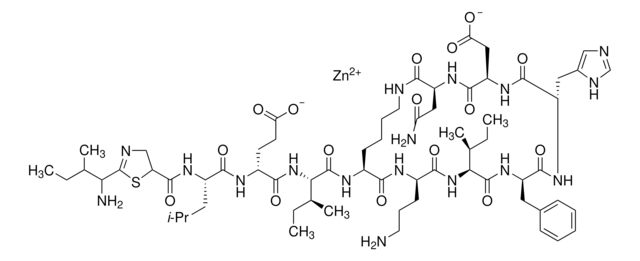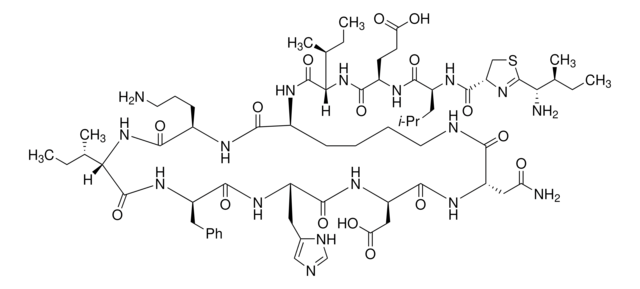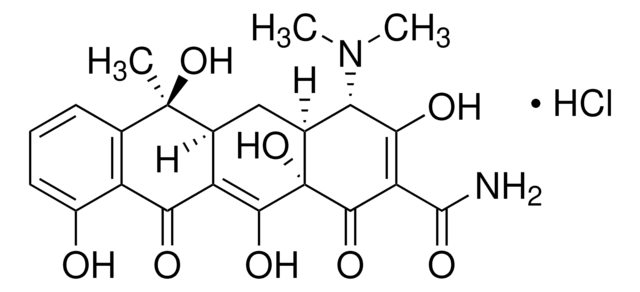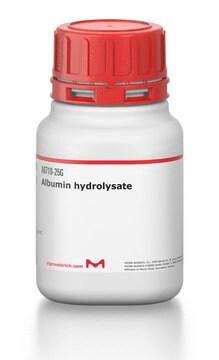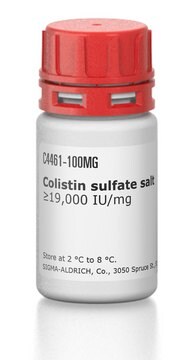B5150
Bacitracin zinc salt
from Bacillus licheniformis, ~70,000 U/g
Synonyme(s) :
Zinc bacitracin
About This Item
Produits recommandés
Source biologique
Bacillus licheniformis
Forme
powder
Activité spécifique
~70,000 U/g
Pf
250 °C (dec.) (lit.)
Spectre d'activité de l'antibiotique
Gram-positive bacteria
Mode d’action
cell wall synthesis | interferes
Température de stockage
2-8°C
Chaîne SMILES
[Zn++].CCC(C)C(N)C1=NCC(S1)C(=O)N[C@@H](CC(C)C)C(=O)N[C@H](CCC([O-])=O)C(=O)N[C@@H]([C@@H](C)CC)C(=O)N[C@H]2CCCCNC(=O)[C@H](CC(N)=O)NC(=O)[C@@H](CC([O-])=O)NC(=O)[C@H](Cc3cnc[nH]3)NC(=O)[C@@H](Cc4ccccc4)NC(=O)[C@@H](NC(=O)[C@@H](CCCN)NC2=O)[C@@H](C)CC
InChI
1S/C66H103N17O16S.Zn/c1-9-35(6)52(69)66-72-32-48(100-66)63(97)80-43(26-34(4)5)59(93)75-42(22-23-50(85)86)58(92)83-53(36(7)10-2)64(98)76-40-20-15-16-25-71-55(89)46(29-49(68)84)78-62(96)47(30-51(87)88)79-61(95)45(28-39-31-70-33-73-39)77-60(94)44(27-38-18-13-12-14-19-38)81-65(99)54(37(8)11-3)82-57(91)41(21-17-24-67)74-56(40)90;/h12-14,18-19,31,33-37,40-48,52-54H,9-11,15-17,20-30,32,67,69H2,1-8H3,(H2,68,84)(H,70,73)(H,71,89)(H,74,90)(H,75,93)(H,76,98)(H,77,94)(H,78,96)(H,79,95)(H,80,97)(H,81,99)(H,82,91)(H,83,92)(H,85,86)(H,87,88);/q;+2/p-2/t35?,36-,37-,40-,41+,42+,43-,44+,45-,46-,47+,48?,52?,53-,54-;/m0./s1
Clé InChI
NKULICGUDKGGRL-FCHFGNCGSA-L
Vous recherchez des produits similaires ? Visite Guide de comparaison des produits
Description générale
Application
Actions biochimiques/physiologiques
Mode of Action: Inhibits bacterial cell wall synthesis by inhibiting dephosphorylation of lipid pyrophosphate.
Autres remarques
Code de la classe de stockage
11 - Combustible Solids
Classe de danger pour l'eau (WGK)
WGK 3
Point d'éclair (°F)
Not applicable
Point d'éclair (°C)
Not applicable
Équipement de protection individuelle
Eyeshields, Gloves, type N95 (US)
Faites votre choix parmi les versions les plus récentes :
Déjà en possession de ce produit ?
Retrouvez la documentation relative aux produits que vous avez récemment achetés dans la Bibliothèque de documents.
Les clients ont également consulté
Notre équipe de scientifiques dispose d'une expérience dans tous les secteurs de la recherche, notamment en sciences de la vie, science des matériaux, synthèse chimique, chromatographie, analyse et dans de nombreux autres domaines..
Contacter notre Service technique
